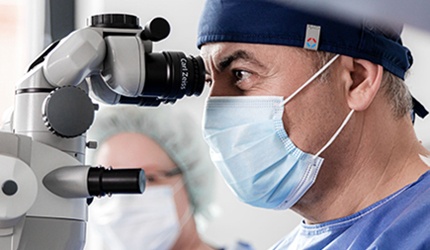

IVOM therapy with Sanoculus
Intravitreal injections for the treatment of AMD
Table of contents
The abbreviation IVOM stands for intravitreal surgical drug administration and is an important form of treatment for age-related macular degeneration (AMD). Here, the drug is injected directly into the vitreous cavity of the eye. Doctors distinguish between dry and wet macular degeneration. While dry AMD is slow,
the wet variant leads to rapid deterioration of vision due to uncontrolled growth of “immature” blood vessels. IVOM therapy can reliably suppress vascular growth. At Sanoculus , IVOM treatment is carried out by experienced doctors who attach great importance to transparent doctor-patient communication.
Sanoculus Ophthalmologists in Berlin
Modern practice rooms for IVOM therapy
In our well-equipped Sanoculus Eye Centers at Elsterplatz and in Spandau , specialists carry out AMD diagnostics and IVOM therapy using the latest scientific findings . For the diagnosis of macular diseases, state-of-the-art equipment is used, with which we can detect changes in the center of the retina at an early stage.

“I’ve had these injections in three different clinics and this is where it was best.”
“I have been injected here regularly for a long time and feel well cared for and have great confidence in Dr. Jerrentrup and his team.”

Prevention & Early Detection:
Age-related macular degeneration (AMD)
Our ophthalmologists recommend that patients aged 60 and over come to our Sanoculus Eye Center once a year for a check-up for age-related macular degeneration (AMD). Currently, special preventive examinations in Germany unfortunately still have to be paid for by the patient. However, the earlier the treatment begins, the better the prospects of good vision preservation through our IVOM therapy in Berlin.
Frequently asked questions about IVOM therapy

For medical colleagues:
Patient referral for eye operations

Are you looking for specialists for eye surgery in Berlin for your patients? If you would like to refer your patient to us, please register them for our consultation hours. Please include any previous findings (hospital letters, old FLAs or OCTs etc.) directly.
This way we can avoid unnecessary duplicate examinations.



